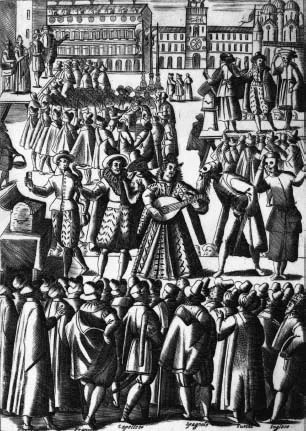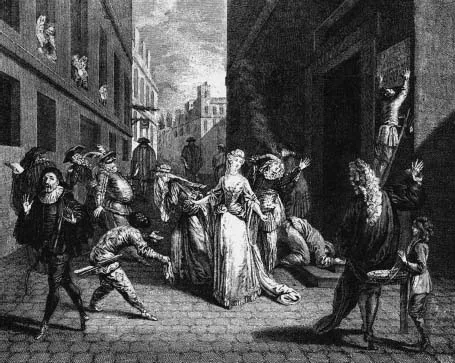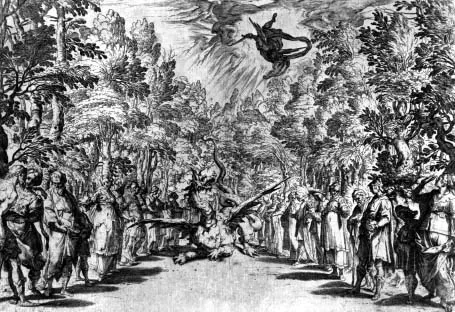![]()
PART I
Down the Road from Arianna to Zauberflöte
c.1600–1800
![]()
CHAPTER I
The Birth of Italian Opera
Anna Renzi was Venice’s prima donna, one of the leading singers of her day, a ‘sweet siren who gently ravishes the souls and pleases the eyes and ears of the listeners’, according to one of her admirers, the dramatist and poet Giulio Strozzi. A portrait of Renzi shows an elegantly, expensively dressed young woman. Her richly coiffed hair is bedecked with flowers and jewellery, and her slashed two-tone bodice, tightly gathered in at the waist, is edged with a delicate filigree lace collar and cuffs. In Renzi’s hand is a sheet of music, but her eyes are looking out knowingly and confidently at the viewer. A ‘woman of few words’, says Strozzi, ‘but those are appropriate, sensible, and worthy for her beautiful sayings’.
As a young man, the English diarist John Evelyn had visited Venice in June 1645 as part of the Grand Tour he was undertaking. During Ascension week, Evelyn went to hear Renzi in an opera about Hercules in Lydia. He was duly impressed (though he thought ‘an eunuch’ in the cast ‘surpassed her’), and he attempted to describe the attraction of the new art form:
This night… we went to the Opera, where comedies and other plays are represented in recitative music, by the most excellent musicians, vocal and instrumental, with variety of scenes painted and contrived with no less art of perspective, and machines for flying in the air, and other wonderful notions; taken together, it is one of the most magnificent and expensive diversions the wit of man can invent… The scenes changed thirteen times… This held us by the eyes and ears till two in the morning.
Opera was one of the entertainments presented in Venice as part of Carnival, a winter-time festivity that in theory ran from the day after Christmas until Shrove Tuesday but which in practice came to be extended in both directions. Here were gathered every kind of freethinker: sexual libertarians, disillusioned priests, rich young Grand Tourists like Evelyn, and a stream of louche actors and musicians from all over Italy seeking work, money and audiences in the city most likely to provide them. During Carnival-time, the wearing of masks guaranteed anonymity to their wearers and broke down social (and sexual) barriers. So long as you kept out of trouble with the city authorities, your life was pretty much your own. Evelyn, revisiting Venice in January 1646 ‘to see the folly and madness of the Carnival’, noted ‘the women, men and persons of all conditions disguising themselves in antique dresses, with extravagant music and a thousand gambols, traversing the streets from house to house, all places then accessible and free to enter’. Here, ‘the comedians have liberty, the operas are open… and the mountebanks have their stages at every corner’. Evelyn records that the ‘diversions which chiefly took me up [were] three noble operas, where were excellent voices and music, the most celebrated of which was the famous Anna Rencia [sic]’, whom he and his companion later invited to supper.
Unlike Florence, Mantua and other northern Italian city-states, Venice was a republic, in many ways an exceptionally liberal, independent-minded one. In 1606, the entire city was, in effect, excommunicated by the papacy for its religious toleration (including towards Protestants). If something was attractive, the Venetian instinct was to flaunt it, perhaps to sell it. The city had long been an essential stopover for wealthy tourists from all over Europe seeking a frisson of danger. In 1594, Thomas Nashe, a contemporary of Shakespeare, published a vivid account in which his characters meet a pimp in Venice who leads them to a brothel, ‘Tabitha the Temptresses’. Tabitha apparently maintained a house of such elegance and refinement that, like ‘any saint’s house’, it contained ‘Bookes, pictures, beades, crucifixes [and] a haberdashers shop… in every chamber’. Tabitha’s whores had not a hair out of place, says Nashe, while on the beds there was ‘not a wrinkle’ to be found and the pillows were as smooth as a ‘groning wives belly’. Nashe’s young men had no complaints. ‘Us for our money,’ he concludes, ‘they used like Emperours.’ At Carnival time, Venice exploded into a riot of license and danger. Evelyn described the way Venetians would ‘fling eggs filled with sweet water, but sometimes not over sweet’, while they also had ‘a barbarous custom of hunting bulls about the streets & piazzas, which is very dangerous, the passages being generally narrow’. Here, by the waterways of La Serenissima, visitors found an exuberant crossroad between cultures where the legacy of the Renaissance met that of Byzantium, art met commerce, East met West.
For all its flamboyance, Venice was also in decline. The Imperial armies that routed Mantua in 1630 brought plague to Venice a year later, killing a quarter of the city’s population of some 150,000 over the next couple of years; fifteen years later, Venice embarked on two decades of recurrent warfare with the expansionist Ottomans, a campaign that drained the exchequer and culminated in humiliating defeat for the Republic in 1669. Deeper, longer-term trends also pointed to inexorable decline as foreign trade gradually diminished and the great trading routes Venice had once dominated were superseded by new roads to the East. Poverty became widespread while the men running the city responded with ever more petty rules and regulations. The Most Serene Republic, it became evident to anyone prepared to peer out beyond the civic mask, was in terminal decay. ‘My eyes are very pleased by Venice,’ commented the French political philosopher Montesquieu; ‘my heart and mind are not.’
In this 1610 engraving from Venice, singers, actors, masquers, jugglers and a snake-charmer perform outside St Mark’s. Many smaller piazzas would have witnessed similar scenes, especially during Carnival: a socially mixed crowd enjoying open-air, multimedia entertainment. Cover the piazza and you have the essence of the early opera house.
Yet, throughout these years, Venice continued to face the world with a broad smile, or at least the fixed semblance of one. Not only during Carnival but throughout the year a sequence of festivals and processions packed the calendar in a triumph of show over substance. Art and artifice acted as an addictive drug, a way of neutralizing traditional moral codes, a permanent diversion from uncomfortable realities. Life imitated art and became something far more comfortable: theatre. Venice was itself the most theatrical of cities, its very fabric providing the greatest spectacle of all: there was theatre on the canals, in the piazzas, in churches, in homes, and people would walk, talk and dress with a vivid sense of theatricality. Above all, this was a city of public theatres, often built by noble families on their vacant city properties, in which travelling troupes of players could usually be sure of a paying audience made up of not just the aristocracy but, potentially at least, of all ranks of society. Performances would typically contain a spoken comedy, interspersed with elements of song and dance and, if the spectators were lucky, some clever stage trickery of the kind that impressed Evelyn. Back in the 1590s, when Thomas Nashe was writing, there were two such public theatres in the vicinity of San Cassiano alone, a short walk west of the Rialto. One of them burned down in 1629 and was promptly rebuilt with brick and renamed the Teatro S. Cassiano. After a further fire and rebuild, it was here at the Cassiano, from 1637, that something like operatic life as we know it today was inaugurated: a form of publicly promoted musico-dramatic entertainment available on a regular or recurrent commercial basis in purpose-built theatres before a paying public.
At the time, the leading musician in Venice and the man in charge of music at St Mark’s Cathedral was the seventy-year-old Claudio Monteverdi. Few Venetians would have known that, thirty years before, in the confines of a Renaissance court in Mantua, their maestro di cappella had also composed perhaps the earliest genuine masterpiece in operatic history: Orfeo.
*
The origins of opera can be dated back a lot earlier still. Throughout history, many societies, often inspired by religio-political motives, have tried to link drama, spectacle, music and movement, and scholars have found fragmentary evidence of some of the words, instruments and stagings used in (for example) Pharaonic Egypt, the amphitheatres of ancient Greece, or the streets and churches and the courtly jousts and banquets of medieval Europe. We have little knowledge of the actual music sung or played in these quasi-ceremonial music dramas, however. In any case, it was probably not until Renaissance times that serious, systematic attempts were made to integrate and to stage all the elements of story and song, words, dance and music. Thus the roots of what we call ‘opera’ can realistically be traced no further back than the stage jigs and courtly masques of the sixteenth century, the intermedi performed between the acts of plays in the Renaissance courts of northern Italy, and that popular semi-improvised Italian theatrical entertainment, the commedia dell’arte, which featured much-loved stock characters such as the lovers Harlequin and Columbine, the miserly old Pantalone and the sad but comic Pulcinella.
In the 1570s and 1580s, a number of well-connected Florentine cultural figures used to gather at the home of the military leader and humanist intellectual Count Giovanni de’ Bardi, where they would discuss the essentials of music and drama. Among the regular members of the Bardi Camerata were the musicians Giulio Caccini and Vincenzo Galilei (father of the astronomer Galileo). Galilei wrote a treatise arguing for a ‘dialogue between ancient and modern music’: a revival, in effect, of what he believed to have been the aesthetic ideas of the ancient Greeks and Romans, most notably the complete integration of music and poetry. After Italy had suffered ‘great barbarian invasions’, lamented Galilei in his Dialogue, ‘men had been overcome by a heavy lethargy of ignorance… and took as little notice of music as of the western Indies’. Nowadays, he asserted, ‘there is not heard the slightest sign of modern music accomplishing what ancient music accomplished’. Neither the novelty nor the excellence of modern music ‘has ever had the power of producing any of the virtuous effects that ancient music produced’. Today’s musicians, Galilei thundered, ‘aim at nothing but the delight of the ear, if it can truly be called delight’. One of Galilei’s concerns was about the ways in which texts were set to music. ‘The last thing the moderns think of,’ he sniffed, ‘is the expression of words with the passion that these words require.’ And he took particular objection to the fashion for polyphony, in which a number of musical lines run alongside each other, advocating instead the clarity of a single vocal line. This, he thought, was how the music of the ancient world had been able to make so powerful an impact.
Italian commedia dell’arte, with its stock characters and story lines, fed directly into what later became known as opera. Its influence is still evident in Rossini’s Barber of Seville, Donizetti’s Don Pasquale and the play-within-a-play in Leoncavallo’s I pagliacci.
Galilei’s views were not original to him, and he and his colleagues were swimming with an already powerful tide. Throughout the Renaissance, there had been an attempt, especially but not only in northern Italy, to revive what came to be regarded as the superior culture of the ancient world and to place the individual human being centre stage. Architects, painters and sculptors, poets, historians and philosophers all aspired to build upon the supposedly humanistic principles underlying surviving Greek and Roman models. The Greek Parthenon and Roman Pantheon, the sculptures of Pheidias and Praxiteles, the works of Aristotle and Virgil – all served as inspiration in the era of Leonardo, Michelangelo, Raphael and Machiavelli. For one cultural form, however, there were no ancient models, and that was music. Philosophers, including Plato, had reflected on the nature and impact of music, and there were plenty of surviving pictures of ancient musicians and music-making and descriptions of musical occasions. But the music itself had vanished. This only served to present a greater challenge to those, such as the Bardi circle, interested in the revival of the ancient arts and learning.
Renaissance art and scholarship received encouragement and funding from some of the wealthiest and most powerful political figures of the day. The munificence of Lorenzo de’ Medici (‘The Magnificent’) helped make Florence a leading cultural centre, while it was the Vatican that commissioned St Peter’s and the Sistine Chapel. In Ferrara, the ruling Este family had long been accustomed to putting on elaborate banquets at which musico-dramatic presentations would be performed for the delectation of guests between the many courses. Here, and in Mantua, courtly entertainments would also often feature elegant, classically based pastorals in which the drama would be set to music and include dance sequences. In Florence, the Medici would mark opportunities for political display such as dynastic weddings with not only gentle pastorals but also more impressive (and expensive) forms of stage entertainment and, between the acts, a series of extravagant, multimedia intermedi. In 1589, the celebrations of a marriage linking the houses of Tuscany and Lorraine culminated with a series of intermedi played in the entr’actes of a drama called La pellegrina. Devised by Bardi and calling upon the talents of several prominent members of his circle, these included not only spectacular scenic effects but also sequences of richly textured vocal and instrumental music and a ballet. ‘Through the depredations of time,’ we read in a pamphlet by one who was there, ‘we have lost the ability to perform such things with the musical modes of antiquity.’ However, although ‘presented to the accompaniment of our modern music’, it was evidently to the credit of the composer (Luca Marenzio, who wrote the music to the second and third intermedi) that he apparently did ‘his utmost… to imitate and re-create the music of antiquity’.
Such intermedi – still, theoretically, mini-performances between the acts of a play – could overshadow the play itself. Some complained about this: one did not go to a show for its intermission features. ‘The wondrous show – alas! – of the intermedi,’ complained ‘Comedy’ in a line by the sixteenth-century Florentine poet and playwright Antonfrancesco Grazzini. However, if pastorals could be so popular and intermedi so potent, some wondered why not extend them. It was thus a natural step to argue, as Vincenzo Galilei did, that music should be played throughout a full-length dramatic performance. Further, Galilei argued that the music should reflect the emotions seen on stage. As in ancient Greece (it was presumed), singers should be given words and music both clearly embodying the feelings they were required to express. To underline the emotions, said Galilei, not only should one melody be played or sung at a time, but the music should follow the natural inflections and rhythms of speech. Galilei composed illustrations of how these principles might work in practice. His compositions have not survived. Some of Caccini’s have, however, and are among the earliest embodiments of principles that, with variations, have tended to lie at the very root of what later generations came to call ‘opera’.
The Florentine Intermedi of 1589 were an early attempt to recreate what was believed to be the ancient world’s integration of music, drama and staging. One featured Apollo’s descent from the clouds to defeat the dragon Python.
It would be misleading to suggest that intermedi or pastorals simply gave way to the new form. On the contrary, there was at first little substantive distinction between the genres. But it is perhaps not altogether fanciful to date the origins of opera as we have come to understand it to around the year 1600 and, more specifically, the celebrations in Florence in October that year of the marriage of Maria de’ Medici to the King of France, Henri IV. The festivities marking the event were highlighted by a performance of a work called Il rapimento di Cefalo in which most of the music was by Caccini. Less noticed at the time, perhaps because it took place in the confined space of the Pitti palace, was Euridice, with text by Ottavio Rinuccini and music mostly by Jacopo Peri (with some unwelcome additions by Caccini). This is the first opera for which complete music has survived, perhaps the first ‘opera’ of all. Rinuccini, alth...



